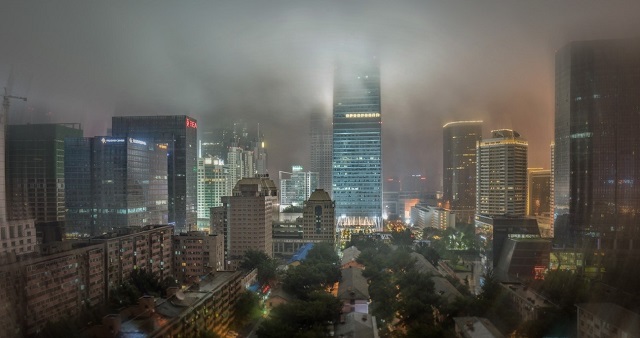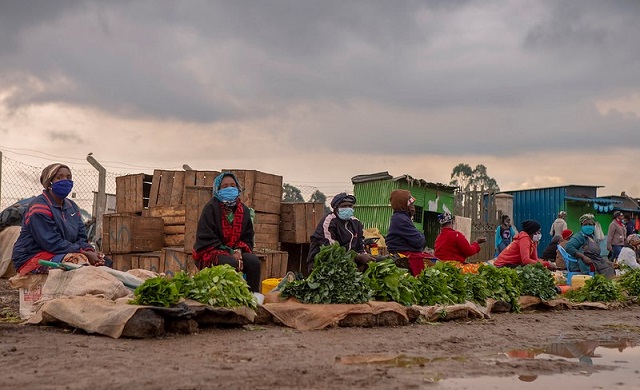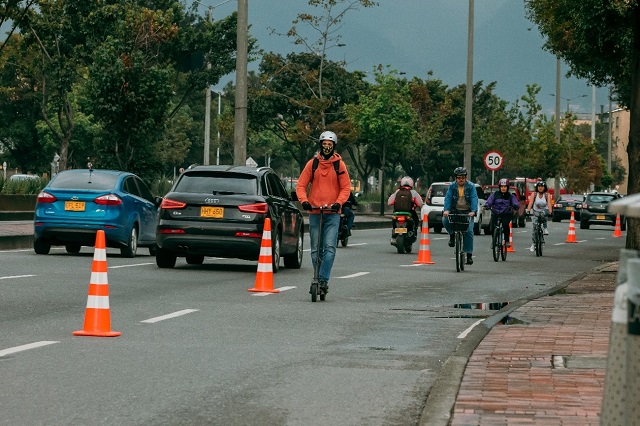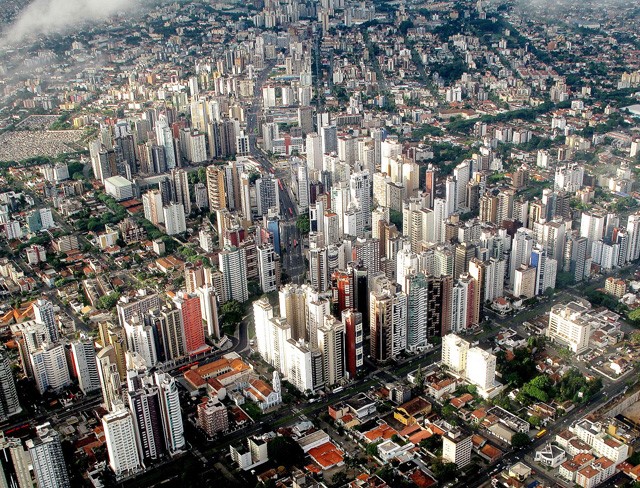
When we think back to what this moment meant for cities, what will we remember? Photo by Jens Schott Knudsen/Flickr
COVID-19 is a radical moment in so many ways. By disrupting urban systems so profoundly, it has thrust the question of urban futures before us in a way that we cannot ignore. Will cities recover? What will they look like? Will they be more inclusive? Will private cars reduce or expand their dominance over public streets and spaces?
History is being made and many paradigms are being challenged. What path we will take from here is less clear.
This is a vision of how mobility might change in developing cities. It is only a dream now – and certainly it will not be a reality everywhere – but let us imagine what thinking back to this moment in 2030 could be like.
The Rise of Active Mobility
The first phase of transformation starts with social isolation. Streets and avenues almost empty. Masks are everywhere. Demand for public transport falls by three quarters. Supply –frequencies and even routes – is cut too, but only by a third to avoid crowding and ensure essential workers can get around and people can access vital services.
Despite these measures, many still have difficulty getting food or to the doctor or to their job, increasing pressure on public transport systems. Plummeting fare revenues, meanwhile, create immense financial problems for operators. Some local and national governments step in to compensate for shortages and prop up struggling systems. Others do not.

A market in Nairobi. Social distancing requirements may compel cities to expand sidewalks and other infrastructure, both for pedestrians and commerce. Photo by Sambrian Mbaabu, World Bank/Flickr
With more people spending time at home than ever before, many cities start to expand public spaces for walking, cycling and other modes of non-motorized transport. Sidewalks are widened and streets are closed to motor vehicle traffic. Some return to pre-automobile era configurations to accommodate walking, queueing to enter shops and eating outside, while maintaining safe distances. On some streets, delivery vehicles of all shapes and sizes become the only ones allowed to circulate to accommodate rapidly growing online sales.
Fewer motor vehicles means less congestion and fewer collisions. Traffic deaths – previously rising nearly everywhere – begin to plateau and decline. Urban air quality improves and many people begin experiencing tangible health benefits from more physical activity and better breathing.
Deep cleanings of public transport vehicles, stops and terminals become routine. As congestion declines, road space becomes less politically contested and priority lanes are assigned to buses to further improve speed, efficiency and reliability.
Systems Begin to Adjust
Many people continue working from home for years. Staggered hours for various services become the norm. Online learning for students of all ages explodes in popularity. The new dynamics of urban life begin to physically reshape cities.
In public transport, morning and evening peak demand curves are flattened, resulting in smaller fleets and generating significant cost reductions in service provision. People start to appreciate the opportunities that come from navigating their city on foot and taking in open spaces free of crowds. Many short, everyday trips that were once done via car or bus, are now happily completed on foot or bike, as people become accustomed to new routines and new neighborhood businesses.
The lull in car traffic creates a new perception of public spaces and there is less tolerance for dangerous, congested roadways, noise and air pollution, and devoting huge areas for parking – conditions that were once taken as a necessity.
Cities build on the many temporary street transformations enacted during the peak of the pandemic – quick and cheap to implement because they required little more than bollards, brushes and gallons of paint – to more permanently and strategically connect cycling lanes to transport hubs and create consolidated urban biking networks that enable safe and integrated trips. Secure bike parking replaces car lots at many major destinations.

Temporary bike lanes, like these in Bogotá, may lead to permanent changes in some cities. Photo by iStock
Developing cities all over the world recognize their role in shaping public spaces by embracing the “Safe Systems” approach to road safety, narrowing lanes and reengineering streets to deliver lower speeds, fewer emissions and huge decreases in road fatalities.
More visible than ever, the negative externalities of urban transport garner more attention from decision-makers, media and residents than ever before. More cities begin levying taxes for the use of road and curb space by transport network companies like Uber and Lyft. Some enact congestion charging rules for all motor vehicle traffic to strategic areas and car- and motorcycle-free zones. Long-term free parking of motor vehicles on streets in dense areas is rethought in many cities. The revenues from charging for externalities are directed to maintain the supply of public transport services, helping to offset the post-pandemic decline in ridership and sustain more service hours at the same time.
The Consolidation of More Inclusive Mobility
Cities that heeded the challenges posed by the intermittent waves of the coronavirus are reaching a new equilibrium. With increased space for pedestrians and cyclists, improved non-motorized connections to public transport hubs, and safer streets, local businesses are thriving. Economies are more neighborhood-based than any time in recent memory, sparking the regeneration of decayed areas.
Because of more direct, frequent and faster services, revamped and sanitized public transport systems are regaining riders. New sources of revenues, inspired by long-established and consolidated practices like the Versement Transport in France and Vale Transporte in Brazil, give stability to urban transport agencies, allowing for investments in improved quality and modernization. The full digitalization of transport, making extensive use of open data provided by 5G technology, enables tailored, on-demand services. The 1970s-era “dial-a-ride” concept finally becomes a reality beyond private ride-hailing companies.
Galvanized by the need to re-think transport networks and the influx of new data, many local, state and national governments are working together in a much more coordinated way to plan and manage regional mobility. Many metropolitan regions that once had dozens of mayors and transport offices working on mobility, like those in Brazil, establish centralized authorities responsible for regulation, planning and control of transit and traffic operations and data centers. Urban transport operations transcend city boundaries with integrated regional and local fares and fewer overlapping bureaucratic responsibilities. The rationalization of transport supply enables significant reductions in costs. For riders, the experience is simpler than ever. They routinely and without thought combine bus, metro, train and boat systems between and within cities using the same fare system.

Mobility as a service combined with strategic density, like along Curitiba’s BRT corridor, could lead to more inclusive and more sustainable mobility and city planning. Photo by Francisco Anzola/Flickr
Startups making use of open data under mobility-as-a-service principles are enabling new customized and seamless riding experiences that include a variety of connected transport modes, from shared electric and autonomous cars to e-bikes. Improved regulatory mechanisms, the proliferation of transport data, and open access to a huge, consolidated market of users spurs new interest from technology providers, entrepreneurs and investors. Fleets of electric and hybrid-hydrogen buses of different sizes, some of them even autonomous, replace diesel vehicles en masse.
A single governance structure for urban transport and land use planning also creates new calls for transit-oriented development in cities including land value-capture, the benefits of which are clearer than ever. Climate financing is increasingly applied to transport projects which can now clearly demonstrate significant reductions in greenhouse gas emissions. Nature-based infrastructure solutions are routinely incorporated as part of transport planning, thanks to new finance mechanisms that rightly recognize their multiple values to residents, businesses and global climate goals.
The Paths Ahead
This is a vision of positive transformation. Certainly, it will not be case everywhere. In cities that ignore the new dynamics or are abandoned by overburdened or callous governments, we may see a different narrative. Public and private transit operators may collapse. Already constrained for many, access to jobs and the other opportunities of urban life, especially in rapidly growing developing country cities, would drop off a cliff. A blustering variety of motorized, informal transport services would likely fill the vacuum. Congestion, travel times, road crashes and air pollution would skyrocket. People living in poor communities located in distant peripheries would suffer most.
The Indian novelist Arundhati Roy has called pandemics “portals” – gateways between one world and the next. COVID-19 is accelerating a de facto transition of humankind into the 21st century. Cities, especially those in the developing world, should not miss this once-in-a-century opportunity to rethink the status quo and build better urban mobility systems that serve more people, more ably and with less polluting and sprawl-inducing results.
The question of what to do with cars was top of the mind for city planners during most of last century. Now it is the time to put active mobility and public transport first. This is the moment to conceive and implement transport networks capable of reducing the immense gaps between rich and poor, in accessibility to jobs, health care, study and leisure, that derives from the prevailing car-oriented mobility.
We do not cross this 21st century portal barehanded. There is a wide array of sustainable mobility solutions that have been extensively tested across many latitudes and cultures. As societal divides flare and even before the pandemic has receded, we need to act now on this urgent and socially just cause. We know what needs to be done to have more sustainable and inclusive urban mobility. We can take a leap now into that new future.
Toni Lindau is the Director of WRI Brasil Ross Center for Sustainable Cities.





